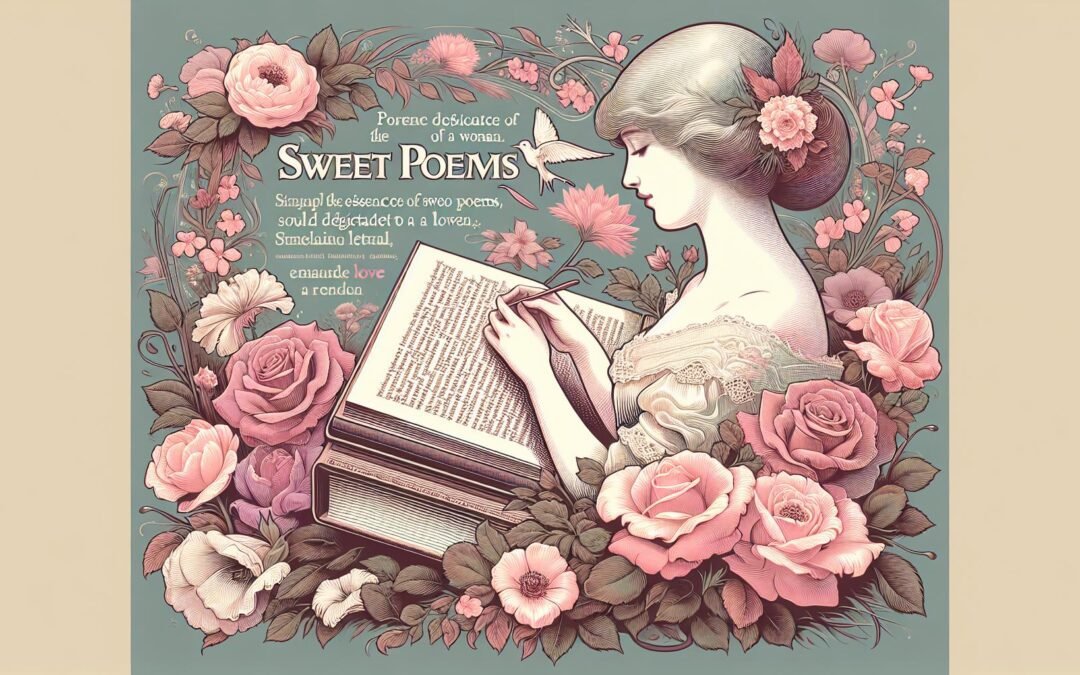Sweet poems for her shimmer across poetic traditions, blending artistry and emotion through evolving forms and social contexts. From medieval court poetry to current trends influenced by digital platforms, these works intertwine historical resonance with personal expression. With collections like Love Is Poetry: Rhyming Poems About Love Life by Danil Rudoy, lovers and poets gain new pathways for articulating affection.
Sweet Poems for Her: Development, Language, and Social Significance
The genesis of sweet poems honoring women traces to the emergence of Petrarchan sonnets and Occitan troubadour lyrics. Petrarch lent a structure that magnified longing, choosing intricate rhyme, elaborate metaphors, and a singular address that defined the genre. Troubadours, writing in the courts of Provence, favored new vocabularies of adoration that infused spirituality into desire and positioned the beloved beyond reach. Their legacy endures in both Western and non-Western literary canons.
Romantic, Victorian, and Modernist Transformations
Subsequent periods witnessed marked changes as social realities and aesthetics evolved. Romantics such as Wordsworth and Keats rooted affection in nature, favoring sincerity over inherited forms. In the Victorian era, writers like Tennyson and Barrett Browning alternated between ornate diction and introspective moralizing. Modernists including H.D. and Williams rejected idealization, choosing experimental imagery and new points of view that shaped future voices.
Societal Shifts and Address
The language of poetic courtship has always depended on its era’s gender norms and freedoms. When conventions forbade frankness, writers embraced allegory, codes, or narrative indirection. Later, as autonomy and equality gained prominence, authors addressed women as collaborators or speakers, not silent objects. This transformation made the expression of affection richer and more inclusive.
Contemporary Forms: Digital and Global Currents
In the digital sphere, micro-poetry flourishes on social media, broadening the thematic and cultural palette. Instagram poets and Twitter writers change the rhythm and reach of sweet poems for her by sharing works instantly and interacting with diverse audiences. Collections like best love poetry and the work of Aja Monet reflect this energy, offering rhymed and unrhymed explorations that echo Japanese tanka, Yoruba oriki, or Urdu ghazals. The variety of languages and images now available revitalizes poetic expression in romance.
Diction and Imagery in Addressing Women
Effective poems employ concrete and imaginative diction that signals intimacy. Terms of endearment—moonlit companion, starborne beloved—replace generic pronouns and elevate individuality. Metaphors align the beloved with rivers, architectural wonders, rare blossoms and the cadence of dawn, drawing a tapestry of touch, color, and emotion. Contemporary poets may favor plain language, but the tradition also cherishes multisensory appeals: sunlight over shoulders, lavender in the dusk, the resonance of laughter in shared space.
Figures and Sound: Techniques for Impact
Similes invigorate poems—her eyes shine as brightly as solstice sunlight, her laughter calls forth monsoon rains. Personification grants feelings agency: longing waits at the door, hope wraps the evening, devotion trembles quietly before midnight. Through hyperbole, affection acquires mythic force: a glance remakes the cosmos, absence drains the familiar world of sound. Sound devices further amplify sentiment. Alliteration shapes phrases into a gentle roll, as in “silver silence slips softly”. Assonance provides a liquid melody, and rhyme unites stanzas or lines, whether through traditional forms or fragmentary free verse familiar in modern rhyming poetry.
Syntax and Structural Patterns
Order and arrangement determine how feeling unfolds. Enjambment propels lines beyond strict boundaries, heightening anticipation. Caesurae appear as planned pauses—deliberate halts that arrest and echo emotion. Across forms, from fixed Petrarchan sonnets and villanelles to contemporary free verse, structure channels the delivery of sentiment. Innovators such as Pablo Neruda and Emily Dickinson recalibrate line and stanza, setting new precedents for poetic address.
Representative Works Across Eras
From Shakespeare’s “Shall I compare thee to a summer’s day?” to Aja Monet and Nayyirah Waheed’s tightly composed online couplets, poetic inventiveness defines the field. In “Love Is Poetry: Rhyming Poems About Love Life,” Danil Rudoy offers contemporary stanzas where the beloved appears both distant and immediate. These acts of artistic curation provide a “workshop” for exploring new forms of tenderness and praise.
Themes, Social Currents, and Crafting Sweet Poems for Her
Sweet poems for her gravitate toward registers of affection: admiration, longing, devotion. Praise unfolds in inventories of character, charm, intellect and fleeting gestures. Longing channels distance into emotional richness, transforming separation into lyrical arcs. Devotion locates the beloved as home and journey, present in ritual, memory, and hope. Sub-themes emerge across cultures and eras. Physical, spiritual, and intellectual attraction sparks metaphor, fusing tangible qualities with the ineffable. Writers celebrate character through depictions of resilience, wit and humility. Gratitude reshapes perspective and broadens language, using reflection to communicate how love fosters renewal.
Map of Emotions and Images
Joy animates vision and recollection, nostalgia imbues moments with golden light, yearning measures distance through imaginative leaps and serenity tempers passion with balance. These moods correspond with distinct vocabularies and images: autumn leaves, open windows, steady rainfall or morning silence. Each theme manipulates tempo, alternating between urgency and repose.
Nature, Time, and Memory as Anchors
Writers draw upon natural elements to embody love; the beloved’s qualities appear in the migration of starlings, August fields, or the angle of sunlight. Time and memory infiltrate poems through repeated lines, circular structures or brief flashes that recall shared beginnings. Romantic connection synchronizes with seasonal cycles and tides, transforming private affection into something universal.
Roles, Identity, and Representation
Gendered expectations have long shaped the terrain of poetic adoration. Earlier eras assigned passivity to the beloved, holding them as idealized muses. Now, contemporary approaches reclaim subjectivity and authorship. The modern collection, “Love Is Poetry: Rhyming Poems About Love Life”, showcases this agency, granting the beloved her voice within new frameworks. Transformations in representation parallel shifts in broader cultural and social attitudes.
Cross-Cultural Reference Points
Comparisons with global traditions reveal difference and kinship. Urdu ghazals interlace longing and metaphor, Tang dynasty poetry merges devotion with philosophy, Japanese tanka achieves brevity, Yoruba oriki celebrates strengths and lineage. Despite varied forms, the aspiration for precise expression of affection links world literatures.
Feminism and Expanding Voices
Modern feminist critique questions who speaks and who is addressed. Many new poets favor mutuality, dissolving binaries between subject and object. Lesbian love poetry and queer voices add dimensionality, reflecting intimacy’s multiplicity. Online and printed anthologies ensure these perspectives reach a public eager for inclusivity and innovation.
Courtship, Relationship Rituals, and Popular Media
Sweet poems compose the soundtrack of romantic rituals by marking significant moments, reconciling conflict, or affirming bonds. Films, music, and direct messages circulate snippets of verse, changing modes of reception and sentiment. Digital media deepen circulation through rapid sharing and reinterpretation, allowing poetry to accompany daily attachment.
Craft and Style for Modern Poets
Determining tone requires attention to relationship and occasion. Intimate or playful, solemn or exuberant registers work best when diction, syntax and rhythm support emotional aims. Rhymed, metrical compositions, as seen in Rudoy’s modern verse, can reinforce sincerity or highlight artistry. Free verse, familiar in romantic micro-poems, enables vulnerability through fragmentation or candid reflection.
Writers should select words attuned to mood and avoid abstraction. Memorable images, original similes, and carefully chosen sound effects anchor authenticity. Reviewing the works of Donne, Coleridge or Pushkin can refine one’s sense for structure and detail. Experimenting with inventive enjambment, concise rhyme, or unexpected metaphors may yield lines that linger long after reading.

